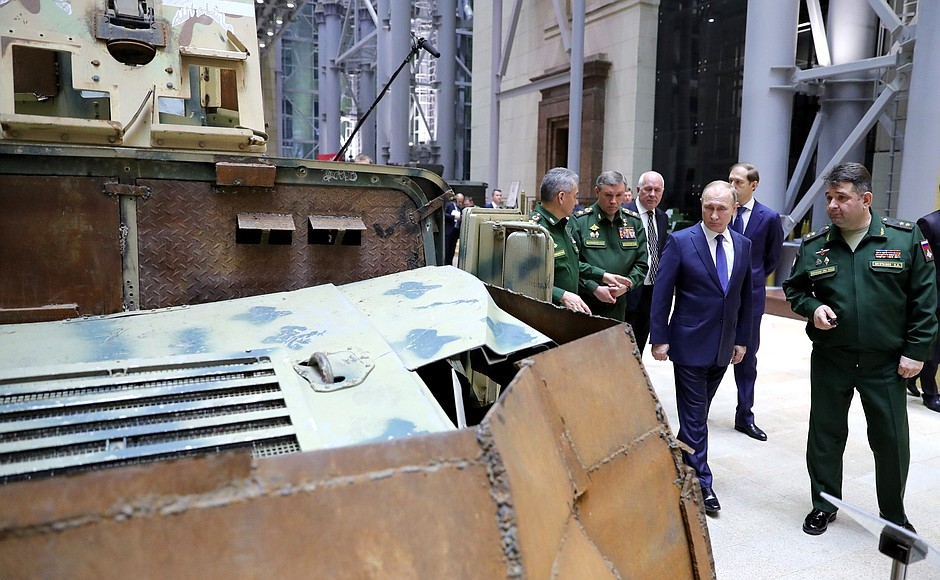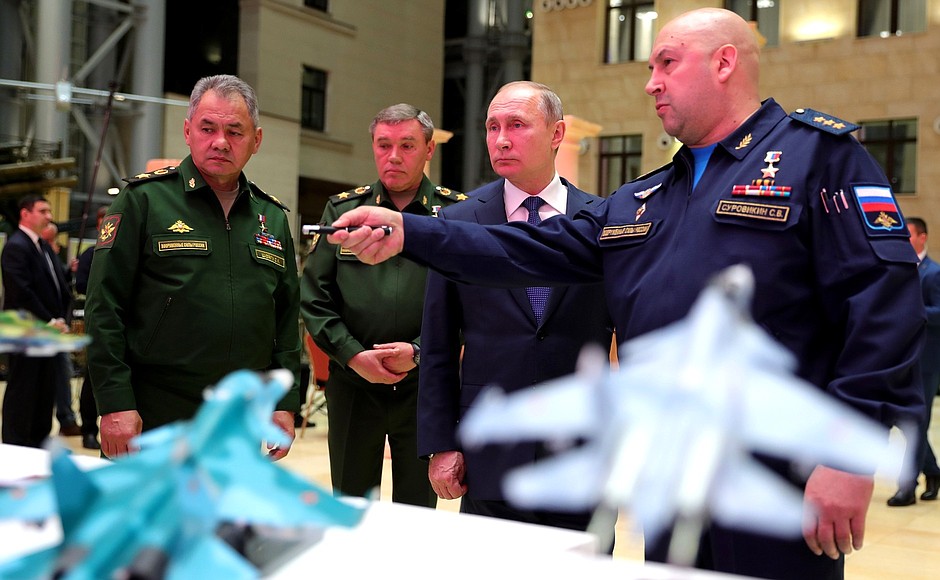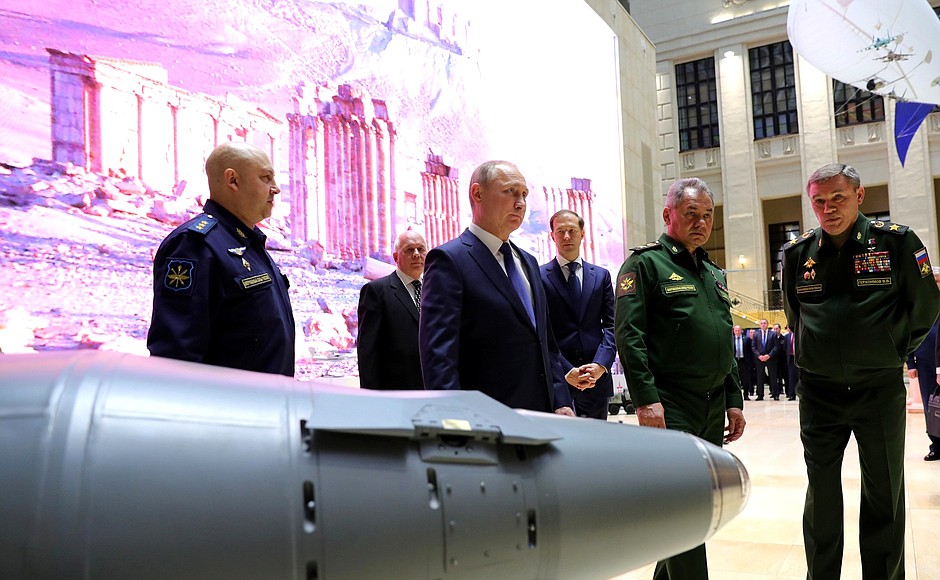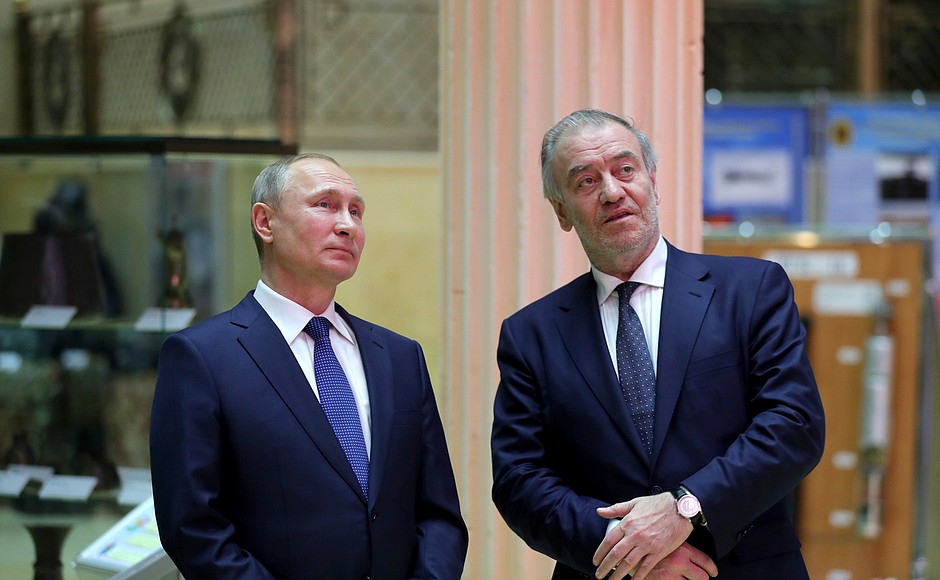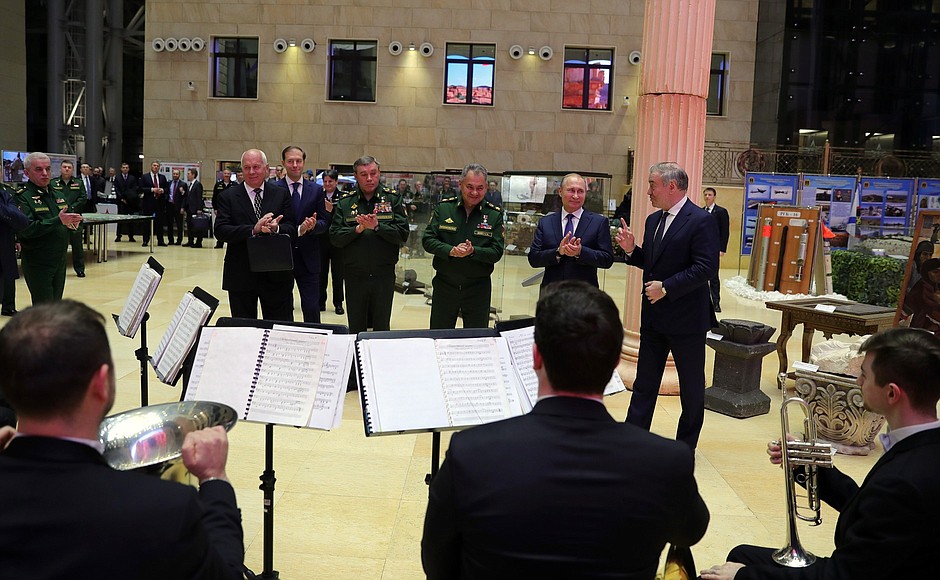The conference is attended by heads of federal ministries and departments, senior executives from the Defence Ministry, and representatives of state corporations and defence industry enterprises.
The agenda includes the use of weapons, military and special equipment in Syria. The overall effectiveness of the weapons systems and the specifics of using individual weapons, as well as the operation of defence industry enterprises, including those engaged in use, repair and maintenance, were analysed.
The results of the conference will be considered during the further implementation of the state armament programme.
The President also examined a thematic exhibit timed to coincide with the conference. Arms, hardware, material and technical, medical and other equipment that was used in the fight against terrorists and also weapons confiscated from commandos are displayed at the exhibit.
In particular, the President was shown the so-called jihad-mobiles (vehicles designed to detonate fortifications and explode with drivers for the maximum damage), drones of armed gangs, and self-made explosive devices used by the extremists.
The President was informed about the specifics of using and equipping Russian combat aircraft and helicopters. He was also shown on mock-ups the formation of the battle order of Russian warships that took part in the counterterrorist operation. Military experts told the President about counter-weapons and special sapper equipment used for lifting mines.
The Syrian authorities presented display items of major historical and cultural value especially for the exhibit. Many of these items were saved from barbarous destruction by the joint actions of Russian military and the Syrian Army, for example, during the liberation of Palmyra.
In this part of the exhibit the President was met by Valery Gergiev who conducted the symphony orchestra concert in Palmyra after its liberation. The President and the Maestro had a brief conversation and then listened to a piece from the Preobrazhensky Regiment March – it was played by Mariinsky Theatre musicians invited to the exhibition.
* * *
Speech at the military-practical conference on lessons learned and summing up the results of the military operation in Syria
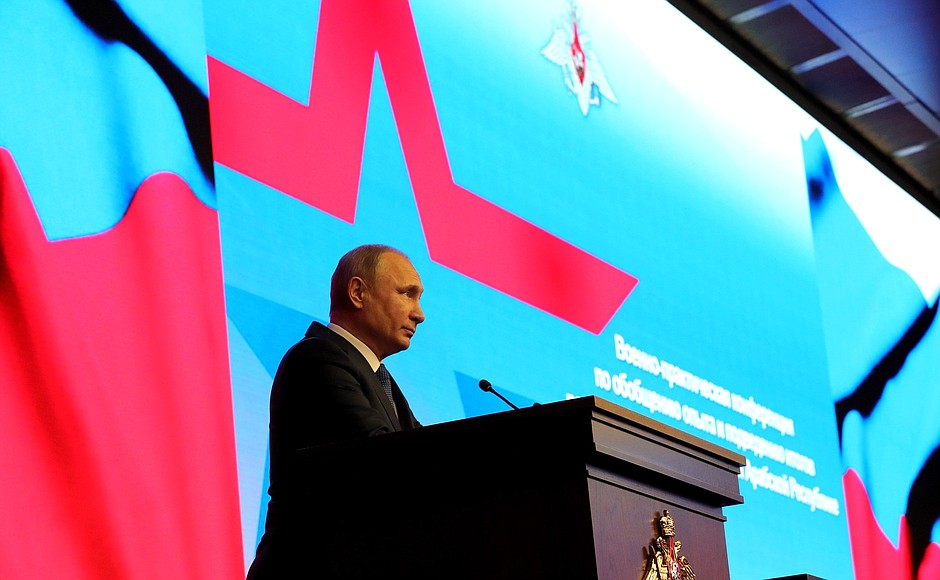
President of Russia Vladimir Putin: Comrade officers, colleagues, welcome to the military-practical conference dedicated to the results of the military operation in Syria.
As you are aware, today we will not be talking about any political results, which we will strive to achieve in other field – diplomatic; a corresponding conference is taking place in Sochi, as you may be aware. Today, we will discuss the latest weapons systems and equipment that were used.
We have with us today senior executives from the Defence Ministry, representatives from our country’s defence industry, as well as service members who used aviation and other equipment in real combat operations, and those who monitored targets at air defence command posts, and conducted rocket launches.
I believe this meeting is extremely important as we continue to work on the advanced development of the Army and Navy. As I said, we need to thoroughly analyse our weapons and equipment’s performance in different situations. We have done this already, talked with you – with many of those present here today – at various meetings, including at our joint meetings in Sochi.
However, today we will do a much deeper and broader analysis, and we will do so in a very honest and candid manner without looking back to any figures of authority. We have nothing to fear, and we must discuss every issue that comes our way. This is the only way for us to achieve the ultimate result in terms of quality.
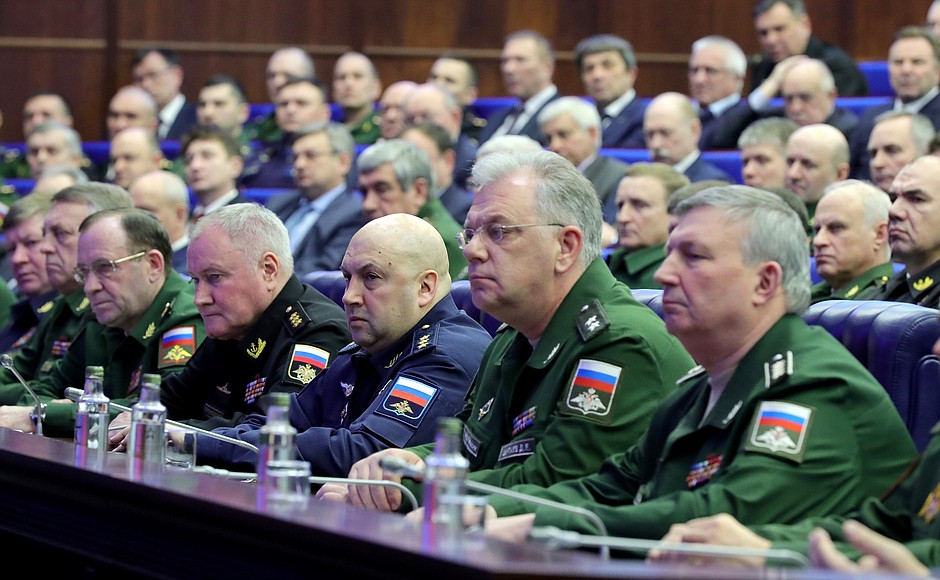
Today, if we turn a blind eye to any shortcoming, tomorrow it will naturally affect our Armed Forces’ combat capability. However, we should, on the other hand, build on our experiences, constantly improve the capabilities of our weapons, and create new advanced hardware.
The rout of the well-equipped terrorist groups in Syria demonstrated the power of our Army and Navy, and the course of the operation demonstrated the tradition of reliability and effectiveness of Russian weapons.
According to the Defence Ministry, 215 advanced types of weapons and most types of hardware are already being used by the troops, and in general they reaffirmed their high performance.
The first experience of the combat use of long-range air- and sea-based systems proved to be positive. These were primarily the Kalibr missile and the X-101 missiles that are less known to the public. Strategic aircraft were also used in combat conditions for the first time.
Tactical aviation and drones also performed well enough for their objectives, to put it modestly. Supported by fighter aircraft, the S-400 and Pantsir air defence systems guaranteed the superiority of our Aerospace Forces in Syrian air space. Clear control over air traffic was established in the skies of the entire region where strong air force groups of several countries operated. Navy forces were also well coordinated. Warships and submarines dealt precision and concentrated strikes at terrorist infrastructure. In addition, Su-33 and MiG-29K ship-based aircraft took part in hostilities for the first time.
I would like to mention that over 1,200 representatives from 57 defence industry enterprises and research organisations visited Khmeimim base and the port of Tartus during the overall operation. They promptly corrected 99 percent of the identified defects in combat equipment and arms.
Our colleagues here know that as these defects were identified and sometimes quite suddenly, we said at our meetings… to put it properly, we did not sugar-coat anything but spoke always to the point and sometimes emotionally.
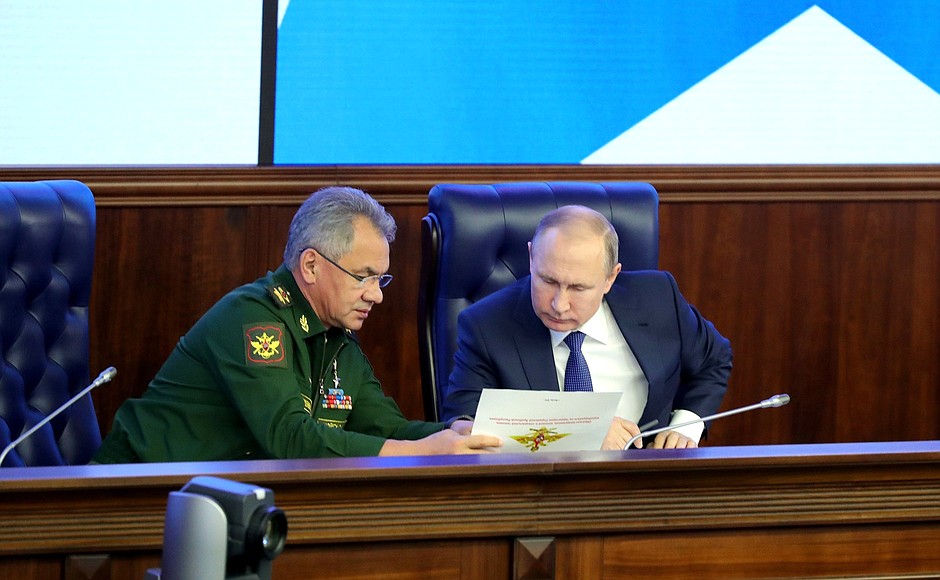
But today, using this opportunity to sum up the results of our work, I would like to thank you and all your colleagues, all employees of the Russian defence industry – engineers, specialists from the working professions and designers, for your efforts and your contribution to consolidating the country’s defence capability, for your major input into the success of the anti-terrorist operation in Syria and ensuring Russia’s defence capability. We will certainly think of how to award the best workers in the industry. The use of our weapons in Syria convincingly showed that in terms of combat equipment the Russian Army is one of the world’s best. Moreover, we are unmatched in a number of arms systems.
No one’s head should be in the clouds, of course – we are perfectly aware of the progress in weapons made by other countries, so there should be no illusions. We should always be one step ahead. To ensure this level of development in the Armed Forces, we need to work on this constantly, we need to work hard and in close cooperation.
I have already mentioned this, but I would like to repeat that some of the weapons and equipment samples revealed flaws in Syria. The objective control data say as much, as well as the firsthand feedback from our servicemen who took part in the hostilities.
I am asking you to carefully study this information and make prompt adjustments to the production process; we have repeatedly discussed this at our meetings and, if necessary, please organise additional research, testing and development work to bring the samples up to the required level.
This has actually been done for some types of weapons, for some equipment samples; I know about this and I would like to thank you all again. You have responded promptly. It took intense teamwork, but you did it. The same needs to be done for all the products.
I am asking the leadership of the Ministry of Defence, the general designers and representatives of defence industry companies to keep this issue under constant supervision, to ensure smooth coordination of this work.
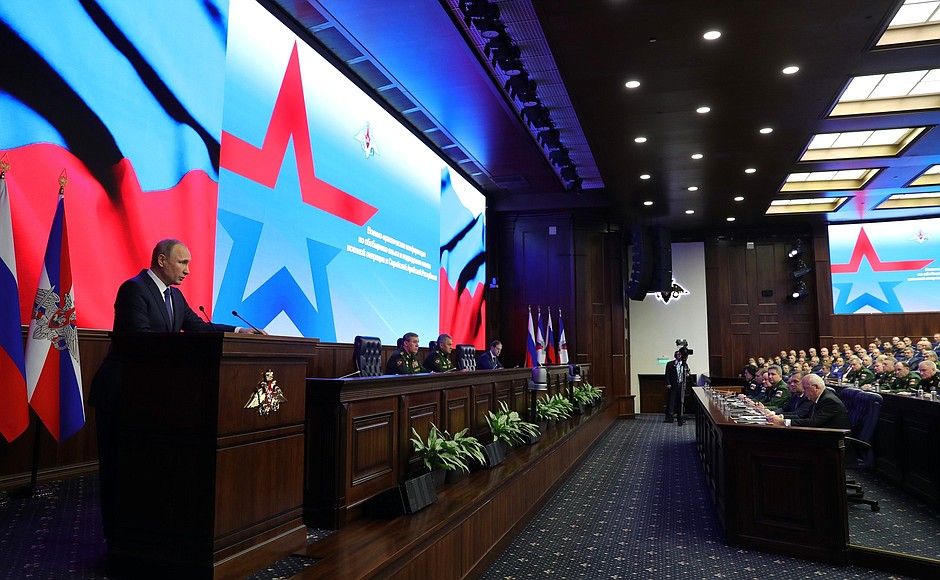
Colleagues, over the past few years, we have systematically carried out the Army and Navy rearmament programme. Now the share of modern weapons is almost 60 percent (59.5), and almost all equipment in parks and bases is in good order: 94 percent, according to the Defence Ministry.
Now we have to take a qualitative step forward. The recently adopted State Armament Programme through 2027 is aimed at addressing this problem, including equipping troops with strike weapons and next-generation reconnaissance weapons systems, and building a powerful technological reserve in the defence industry, something the Army of the future will rely on.
Our research and design schools have repeatedly demonstrated the ability to offer solutions that have outperformed the best foreign counterparts for years, even decades: suffice it to recall the projects of Korolev, Kurchatov, Sukhoi, Tupolev and other outstanding scientists.
Now, in an age of turbulent technological change around the world, we need to ensure Russian leadership and our undisputed edge in military technology. We can and we will.
This will not only give our Army and Navy advanced weapons, but will help develop defence industry cooperation with other countries, and consolidate Russia’s foothold in world markets for modern technologies, both the defence and civilian segments.
In conclusion, I would like to once again thank all servicemen present in this room who participated in the operation in Syria and, of course, representatives of our defence industry.
Let’s get to work. Thank you.

